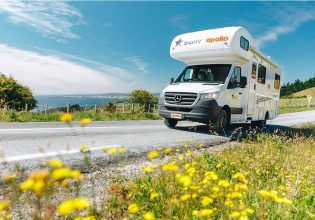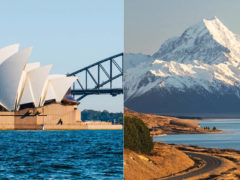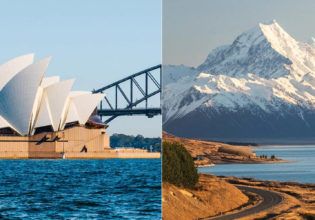75. Top glamping sites & tips for New Zealand


Kawakawa Bell Tent (Image: SJL Photography).
In New Zealand’s indigenous language of te reo Māori, tiaki means ‘to care for people and place’, and the country’s invitation for travellers to take the ‘Tiaki Promise’ inspires visitors to ‘care for the land, sea and nature, treading lightly and leaving no trace’: here is No. 75 of our 101 Reasons To Stop Dreaming About New Zealand And Go.
The portmanteau of camping and glamour might have seemed like an oxymoron when it was first coined in the United Kingdom in the early naughties (the word was added to the Oxford English Dictionary in 2016), but the concept of sleeping under canvas (or in the middle of nowhere) without having to sacrifice creature comforts instantly inspired travellers the world over. You can now find perfectly pitched bell tents, secluded glass-box cabins and cosily appointed yurts absolutely everywhere. One of the prime elements of a glamping experience is an impressive location, whether blissfully remote or jaw-droppingly stunning, something our trans-Tasman neighbours have in spades. Little wonder then that the concept has caught on with gusto in New Zealand, with unique properties strewn like confetti across the landscape from the top of the North Island/Te Ika-a-Māui to the bottom of the South.
Another thing that appeals to so many about glamping is that it is often a much more sustainable and eco-conscious way to travel and stay. Many of the properties in Aotearoa adhere to the kind of sustainable principles that are at the heart of the Tiaki Promise, sitting lightly and respecting the land that they are placed on. The PurePods portfolio is a perfect example, with its stunning glass cabins (even the ceilings are glass to provide maximum stargazing opportunities) that adhere to the company’s ‘minimalist luxury’ approach, and boast expansive locations, clean energy and endless peace and quiet. Even the most cursory search of the internet will offer up an array of glamping options sure to intrigue and inspire.

PurePods sit lightly on the land (Image: Miles Holden).
Places like The Nest at Hurunui Jacks in the West Coast/Te Tai o Poutini region of the South Island/Te Waipounamu, where its cosy tent and adjoining enclosed camp kitchen and bathroom sit nearby the Kaniere River on National Park and Department of Conservation land. Or Valley Views Glamping in Waitaki, with its six off-grid, solar-powered dome tents complete with boho-chic interiors, generous decks and a convivial communal kitchen with potbelly stove.
While many smaller glamping experiences cater specifically to couples, the variety of properties on offer in New Zealand guarantees lots of choice for families too (flamping anyone?). The campsite at Kawakawa Station on Cape Palliser, two hours’ drive from Wellington/Te Whanganui-a-Tara, has a bell tent and a smaller hut accommodating up to five in comfort, as well as the prerequisite outdoor bathtub.
The Camp at Lake Hāwea near Wānaka is big on scenery and options, with both bell tents and safari tents, with an on-site food truck serving up breakfast, lunch and dinner during the camping season (October to April).

Check into The Camp at Lake Hāwea (Image: Sophie Piearcey).
Located on the Banks Peninsula at Little River, 50 minutes from Christchurch/Ōtautahi, the Green Antler sits on a deer farm surrounded by rolling hills, with a stylishly decorated family-sized safari tent with queen bed and bunks.

Green Antler combines perfect views with stylish interiors.
Quirky options abound, too: The Flying Fox’s glamping tent, Bellbird Corner, is situated on the Whanganui River in Whanganui National Park and can only be accessed by aerial cable car or boat; while at Mountviews Glamping in Taupō you can stay in a retro caravan fitted out in a bright and cheery blue palette. The Yurt at Wai Rua Escapes in Whangarei in the North Island wouldn’t look out of place in Mongolia, but was designed and manufactured in New Zealand, its walls lined with wool to increase the cosiness.
Find a comfortable campsite
Liz Henderson and Sonia Minnaar started Canopy Camping in 2012 to make it easy to find unique escapes in lovely locations, the kinds of places they wanted to experience with their families. The roster of glampsites in their hand-picked and meticulously curated collection ranges from luxurious to quirky, all of which have a story to tell and unforgettable holiday memories to be made (with prices starting at just $190 a night). Here, Liz offers up her expert opinion on all things glamping in New Zealand.
Why glamping?
We wanted to experience ‘comfortable camping’ in beautiful places ourselves. We loved the idea of sleeping under canvas, somewhere remote, in a comfortable bed and with a hot shower waiting for us in the morning. We came across glamping as a growing trend in other parts of the world and thought it would be perfect in New Zealand. It hadn’t taken off here at that stage – so we set about making that happen!
Why do you think glamping has become so popular around the world?
The pace of life in most parts of the world has increased. The chance to escape the rat race, switch off from technology, slow down, and spend quality time with friends and family in a beautiful, natural environment is very appealing. Many city dwellers are so disconnected from nature – I think people crave that connection on some level.
What are the unique appeals of glamping in New Zealand?
It’s a chance to fully immerse in the NZ landscape… the West Coast sunsets, the Central Otago mountains, the incredible native forest. It’s an experience – and it’s completely different to staying in a hotel or motel. You’ll enjoy stargazing from outdoor baths and roasting marshmallows on the campfire – things that you can’t typically do at more ‘ordinary’ accommodation.
Do you have a few favourite properties you would recommend?
Too many to mention! But the West Coast huts near Punakaiki in the South Island are all fantastic, and the Central Otago spots are breathtaking.
Why should Australians experience glamping in New Zealand?
Going glamping in New Zealand is a great chance to get off the well-worn tourist routes and let these magical glamping spots set the agenda. Most of our campsites and huts are set on private land, not available to the everyday traveller. Not only do people get to experience staying in these spots, in many cases they also get to meet the owners of the property and get first-hand advice on what to do and see.
Return to 101 Reasons To Stop Dreaming About New Zealand And Go













LEAVE YOUR COMMENT